Improve your ecommerce customer experience with these 9 CX strategies

The ecommerce customer experience is the new battleground for online retailers. In this article we take a deep dive into ecommerce CX and reveal the strategies major retailers are using to boost their CX and customer loyalty. Backed by dozens of surveys and reports, these 9 tips and tricks provide a path for retailers looking to improve CX.
Improving the ecommerce customer experience (CX) is the top priority for online retailers across the globe. CX ecommerce leaders are achieving major revenue growth by creating memorable experiences for customers and catering to their needs and expectations.
But what is customer experience? How important is CX? And what key CX strategies can online retailers use to boost sales, loyalty, and customer satisfaction?
What is the ecommerce customer experience?
The ecommerce customer experience encompasses every touchpoint customers have with your brand. It includes the marketing, the conversations customers have about it, their interactions with customer service, the design of your ecommerce website or app, even the delivery and use of products or services.
Improving customer experience in ecommerce not only helps customers form a positive sense of your brand, but encourages them to return to it, buy again, and recommend it to friends, family, and colleagues.
How important is ecommerce CX?
The short answer is: CX is crucial for ecommerce businesses. Two-thirds of companies now compete based on CX. And CX is the top priority for business professionals over the next five years. Good CX boosts customer loyalty and satisfaction, conversion rates, average order value, and word-of-mouth marketing.
The long answer we’ll tease out throughout the 9 CX strategies in this blog.
9 ways to improve ecommerce customer experience
- Personalize the shopping experience
- Bolster customer service
- Strengthen your UX foundations
- Take UX to the next level
- Tap into social proof
- Highlight your brand values
- Create compelling content
- Make shopping flexible and easy
- Step-up on shipping & deliver on delivery
1. Personalize the online shopping experience
Personalization is a key element of the ecommerce customer experience. Personalization not only makes customers feel seen but also allows online retailers to increase conversions by offering tailored discounts and product recommendations. A massive 80% of consumers say they’re more likely to do business with a company that offers personalized experiences.
Personalization is also one of the few reasons customers are willing to share their precious data with retailers, with 65% of shoppers saying they’d share their data for value-adding personalization.
Think with Google reports personalization gives value to customers when it:
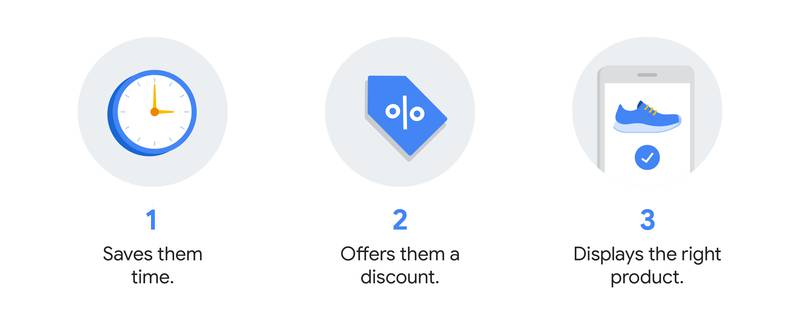
Personalization is a major ecommerce CX trend because it lets retailers provide that personal touch that was once limited to in-store experiences. And like in-store shopping, personalization increases impulse buys and average spend. 49% of customers reported they’ve made impulse purchases after receiving personalized recommendations. And 40% of consumers said they're likely to spend more when encountering highly personalized experiences.
Common personalization tactics for better CX include:
- Displaying previously viewed items
- Tailoring product recommendations
- Automating discount codes on birthdays or anniversaries
- Implementing loyalty programs
- Notifying customers of abandoned carts and offering discounts
- Personalizing marketing and landing pages
If you’re looking to optimize your ecommerce store to improve CX, these personalization strategies are key.
RELATED: Customer Loyalty in Ecommerce: The Surprising Benefits of Fairness
2. Bolster ecommerce customer service
The unfortunate fact of retail is things can’t always work perfectly for every customer. And it’s when things don’t work that customer service becomes the essential tool to salvage and protect CX.
Ecommerce customer service is undergoing a shift, and chat functions and self-service methods are playing an increasingly large role.
Tap into live chat and chatbots
Live chat and chatbots are the emergent customer service tools for ecommerce. Live chat is now the preferred method of ecommerce customer service among shoppers aged 18-49, and 63% of customers are more likely to return to websites that offer live chat.
Beyond live chat, chatbots can now answer many commonly asked customer questions. 91% of chatbot interactions are now completed without a customer service agent being involved.
Implementing chat bots allows retailers to provide 24/7 customer support without service agents working around the clock. This reduces wait time for customers and saves money for retailers.
RELATED: 5 Helpful Tools Every Online Retailer Should Use
Build a knowledge base
The rise in chat options reveals another key consumer trend: people want to solve problems themselves. Today, 67% of customers prefer self-service over speaking to a company representative.
Building a knowledge base helps customers help themselves. A knowledge base is a centralized collection of self-service information about products, services, or companies. It includes FAQs, articles, how-to guides, community resources, and more.
With a strong knowledge base, customers can resolve issues and find the information they need without needing to contact customer support. A massive 91% of customers would use an online knowledge base if it were available and tailored to their needs.
Train your customer service agents
While chatbots and comprehensive knowledge bases are important, they’re no replacement for customer service agents.
Different customers have different preferences and expectations, so you need to be flexible with your customer service options. While many customers may prefer live chat or chatbots, it’s still important you provide phone lines and an email support form for those who don’t like chat functions.
When customers want to speak to people, they want a genuine conversation, so save the scripts for the chatbots and have customer service cater their interactions to the people they’re talking to. 78% of consumers said their customer service experience is better when agents don’t sound like they’re using a script.
Ensure customer service agents understand the problems customers commonly face and have access to the information required to help customers with their queries. 71% of customers expect agents to have information regarding their previous interactions with the brand and 46% say they’ll abandon a brand if employees aren’t knowledgeable.
3. Strengthen your UX foundations
While customer experience encompasses every touchpoint with your brand, user experience (UX) focuses on the experience customers have while using your products or services. That is, the experience they have as users.
There’s overlap between CX and UX, but UX is more technical and focused on the ecommerce shopping experience and making things easier for customers. It remains, however, a core component of ecommerce CX.

Just as people have foundational needs like food and shelter, so too do users have foundational needs that need to be fulfilled before you can achieve great UX.
Websites and apps that provide a great user experience need to be functional, reliable, useable, and pleasurable—in that order. We’ll first address how to put your website on solid footing, then move to making it a pleasure for your customers to use.
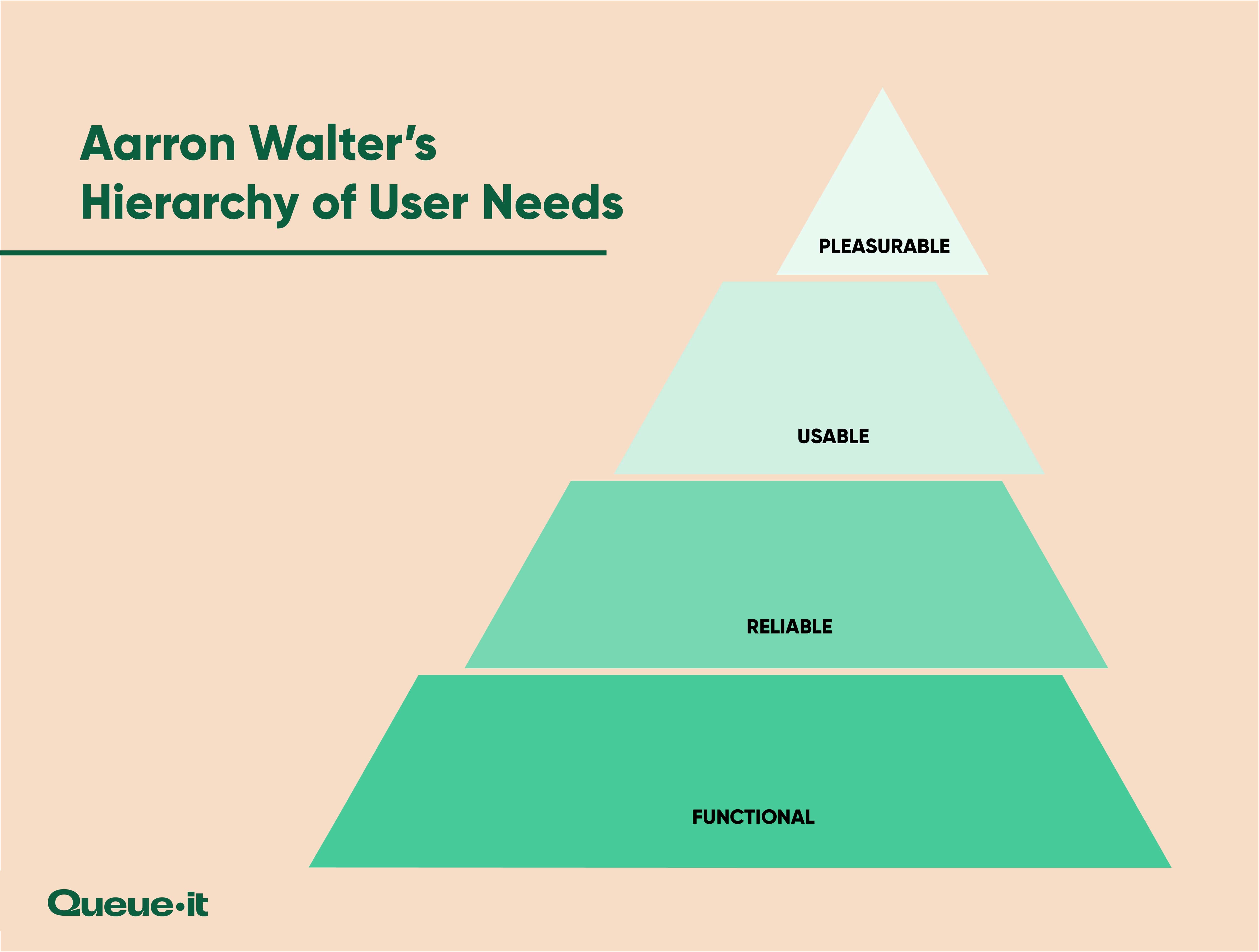
Deliver a functional & reliable site, no matter the demand
Website crashes are a worst-case scenario for retailers, both in the short- and long-term.
In the short-term, website crashes impact sales. Customers can’t make purchases on a crashed website or app, meaning retailers can’t make sales. 91% of enterprises report downtime costs that exceed $300,000 per hour. What’s worse is that website crashes are often caused by high traffic, meaning it’s on the biggest shopping days of the year that ecommerce retailers are most likely to crash.
RELATED: How High Online Traffic can Crash Your Website
In the long-term, website crashes are a major threat to CX. In their Future of CX report, PwC surveyed 15,000 consumers and found that 1 in 3 customers will leave a brand they love after just one bad experience, while 92% would completely abandon a company after two or three negative interactions. These findings are mirrored in a Fullstory survey which found:
- 77% of consumers leave a site without buying if they encounter an error
- 60% are unlikely to return to a site later if they encounter an error
- 65% trust a business less when they experience a problem
Building customer loyalty and capturing repeat buyers is one of the main benefits of CX improvement. But a crashed website threatens this loyalty. When a customer is looking to shop and finds your website is down, they'll look for that item elsewhere. This drives customers to competitors, and many may never return.
Get peace of mind on your busiest days with your free guide to managing ecommerce traffic peaks

Speed up your site to satisfy customers
Website load time is the time it takes for a website or page to fully load. Like the Olympic 100m sprint, mere milliseconds of load speed can have a huge impact on conversion rates, customer satisfaction, and search result rankings.
Conversion rates drop by an average of 4.42% for every additional second of load time, and almost 70% of consumers agree page speed affects their willingness to buy from an online retailer. Slow page speed not only impacts conversions, it also threatens CX by frustrating customers. 54% of people say their frustration increases as the load time of a brand’s mobile site increases, with 80% of customers reporting they find slow sites even more frustrating than crashed sites.
As with website crashes, website load time increases during peak demand, when your servers are under stress. Check out these 11 expert tips to optimize your website performance to find out more on how you can avoid crashes and slowdowns to create a more reliable ecommerce store for your customers.
4. Take your UX to the next level
Once your ecommerce store’s UX foundations are built, you can work on making it a joy for customers to use. Functional and reliable sites are the bare minimum, but by taking your UX to the next level you’ll impress new customers and keep old ones coming back for more.
Intuitive user flow
One of the most important aspects of UX is an intuitive user flow. Customers should never be confused while on your site or app. All the steps to making a purchase should be clear and easy.
We recently ran a LinkedIn poll asking what the most important aspect of online customer experience is. Of the four options, intuitive user flow was the winner by a long shot:
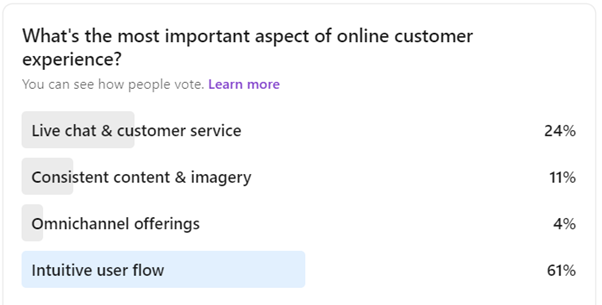
So what does an intuitive user flow look like?
For great UX, keep things as simple as possible and make the flow consistent with other major retailers. The tried-and-true format for a user flow is best because customers understand exactly how to use the site or app. Changing things up often only serves to confuse users.

Source: BSS Commerce
Consistent imagery and copy
Consistency is another key element of improving UX. A consistent ecommerce store is one customers feel comfortable using, one that looks and feels as expected. Brand consistency can increase revenue by 10-20% on average.
Consider major ecommerce retailers like ASOS. They sell products from hundreds of different brands, but all the goods are photographed in their studios and worn by their models.
Why? Because this creates a consistent experience for shoppers.
Were ASOS to take the standard images from each of the brands they stock, customers would struggle to make direct comparisons between products. Some would be on models in a studio, others on mannequins, others in photoshoots outdoors, and others on hangers on a wall.
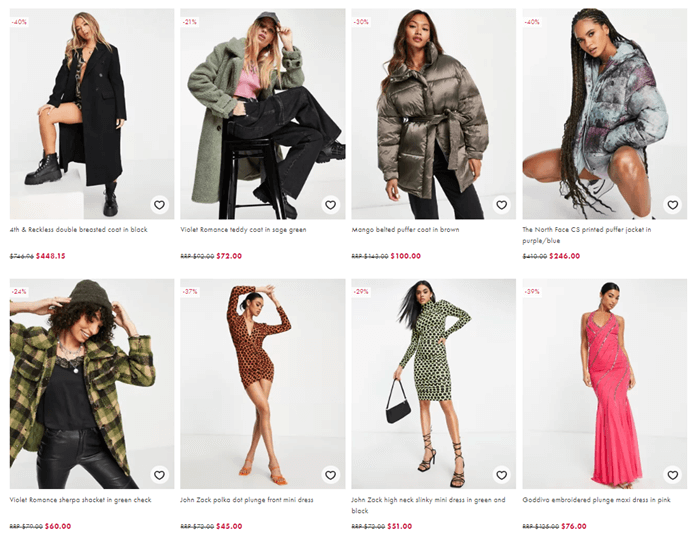
Consistency is equally important for the copy that accompanies products. It’s easier for shoppers to understand and compare products if they are described in the same way.
For clothes, this may mean materials, sizing, the country of manufacturing. For electronics, this may mean inputs, accessories, compatibility with other goods.
Even if you stock thousands of goods from thousands of brands, try to create a uniform experience for customers through a consistent presentation of product information and imagery.
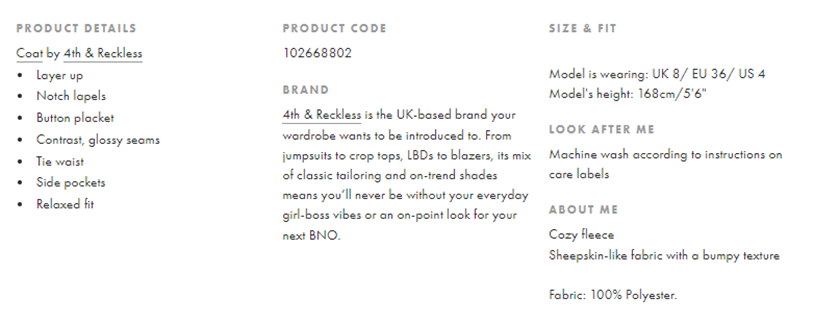

RELATED: How to Improve Your Ecommerce UX with a Virtual Waiting Room
5. Improve ecommerce CX & trust with social proof
Every marketer knows how important social proof is for increasing conversions and building brand trust. But it’s also an important element of ecommerce customer experience.
66% of customers said the presence of social proof increased their likelihood of purchasing a product, and 82% reported that positive star ratings and reviews are the most effective trust signals.
Allow and encourage reviews
There’s a reason most major retailers allow product reviews. Reviews are a great way to get customer feedback, signal trustworthiness, and turn past customers into a resource for future customers.
Accepting reviews not only allows you to understand what you’re doing wrong and fix it, but it also gives customers more confidence in purchasing. 72% of consumers will purchase only after reading a positive review.
Accepting and monitoring reviews is important both for individual product reviews on your website, and third-party services like Trustpilot or Google Reviews. While product reviews are likely to help convert individuals ready to purchase, overall reviews for your ecommerce store will help customers trust your brand and service.

Collaborate with influencers
We’ve stated that CX extends beyond the shopping experience, and a crucial part of this is the associations your brand has in the minds of customers.
Influencer marketing is among the best ways to get brand visibility to a tailored audience, while offering the added benefit of social proof. Rather than running expensive advertisements on television or billboards and hoping the ad finds the right audience, influencer marketing allows you to collaborate with people who are closely related to your brand and customer demographics.
Whether it’s high-fashion clothing, beauty products, video games, or sporting goods, there are thousands of influencers out there with loyal followings, and if you can associate your brand with theirs, you’re sure to gain trust and tap into social proof.
Use a virtual waiting room
Virtual waiting rooms allow ecommerce retailers to show off social proof during product launches or flash sales. When implemented, customers who enter a product launch or sale are redirected into a branded waiting room where they can see exactly how many people are waiting to enter the sale alongside them.
This allows ecommerce retailers to mimic the social proof that's usually created by real-world queues, which have been shown to increase conversions and order value. Virtual waiting rooms tap into customers’ fear of missing out, assuring them they’re in good company when choosing you as a retailer.
RELATED: Why Smart Marketers are Putting Their Shoppers in an Online Queue
6. Highlight your brand values
At its core, the customer experience is the relationship between a brand and a customer. Having a mission and values that are aligned with your customers is an important way to improve that relationship.
It’s difficult to make your brand stand out for more than just how good its products, prices, and services are. But by highlighting and aligning your business with your brand values, you can gain the trust, loyalty, and support of new and existing customers.
Go green
Climate change is the defining challenge of the 21st century, and more and more customers are looking to shop with businesses that practice and support sustainability. 60% of consumers rate sustainability as an important purchase criterion, and 34% say they’ll pay more for sustainable products and services. Sustainability is particularly important for younger generations, with 39% of Gen Z and 42% of millennials reporting they’d pay a price premium for sustainability.
So what do customers want?
A survey by GWI Zeitgeist found that less packaging, recycled packaging, and more affordable eco-friendly products were the most desired factors for sustainable ecommerce.
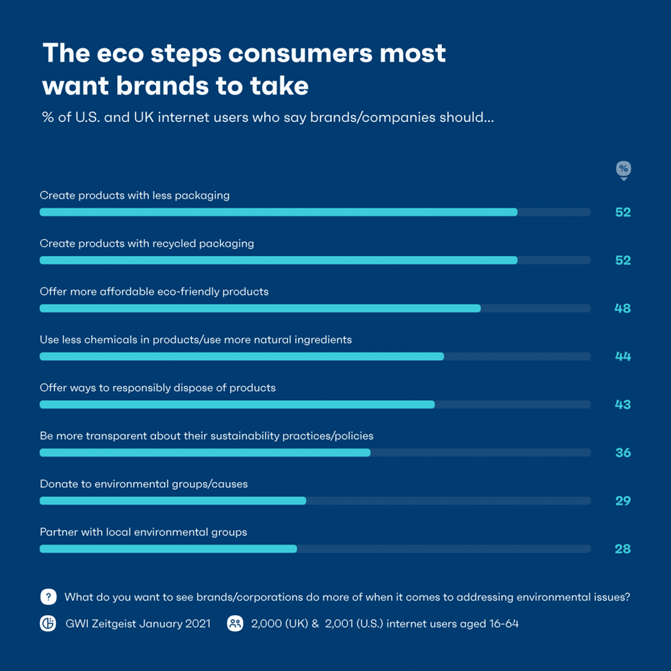
Create value-driven campaigns
Most brands are outwardly aligned with values like sustainability, diversity, and equality. But customers are skeptical of “green-washing”. It’s easy to write something on a website and create some social media posts, but showing commitment to your values in practice is the best way to gain customers’ trust and loyalty.
Patagonia is an example of a brand that’s nailed its commitment to sustainability and gathered massive support thanks to it. Patagonia actively supports environmental activism, donates to environmental causes, encourages customers to buy second-hand items, and has opted out of Black Friday sales for years.
Patagonia ran Black Friday ads one year asking customers not to buy their jackets, taking a stance against rampant consumerism. They told customers that if they did shop with Patagonia, the proceeds would be donated to environmental causes. They estimated Black Friday sales to reach $2 million, but following the campaign, they made over $10 million on the day, donating it to support sustainable initiatives.

If you have values that are important to your brand and that your customers care about, show them you’re truly committed to the cause through more than just words.
7. Create compelling content
The best ecommerce customer experience leaders focus not just on their products and services, but on creating helpful, interesting, and engaging content.
Help and engage customers with blogs, articles, and news
A blog or articles section gives customers more ways to engage with your brand. Blogs provide a space for you to answer questions that don’t fit naturally into other sections of your site and improve your rankings on search engines.
Below are two examples of blogs from major retailers. As you’ll see, their content is tailored to their brand and product offerings.
The first, END. Clothing, is a high-end fashion retailer. Their articles include information about upcoming sneaker drops, interviews with designers, deep dives into fashion trends, and features on new collections from brands they stock.

The second is Best Buy Canada’s blog. They provide holiday season shopping recommendations, product reviews, guides to purchasing items, and competitions and giveaways.

The advantages of creating content like this should be obvious. For END., people interested in sneaker drops and fashion collections read about them on a site that sells them. For Best Buy, people who are looking for holiday gifts or interested in purchasing a TV get information from the retailer that sells them.
Both retailers use their blogs to create new touchpoints with customers and prospective customers, raising brand awareness, affinity, and engagement.
So consider what questions your customers are asking, what areas they are interested in, and what topics are a good fit for your brand. Once you know this, start producing content to engage existing customers and draw in new ones.
RELATED: How Luxury Brands are Creating Elegant Online Shopping Experiences
Social Media marketing
Social media marketing has emerged as a major ecommerce player in recent years. As with blogs, social media marketing is about creating new touchpoints by providing content your customers want to see.

Walmart, for example, has bet big on social media marketing with great success. They’ve hosted live-streamed shopping events on TikTok, collaborated with influencers, and provided fun and light-hearted content to boost their TikTok follower count to an impressive one million users.
8. Make the ecommerce shopping experience flexible and easy
The advantage of ecommerce shopping is your sales aren’t limited by location or foot-traffic. But when selling online, you’re catering to customers with more diverse shopping habits and expectations than in a brick-and-mortar store. It's crucial retailers recognize this in optimizing their ecommerce stores by making the shopping experience flexible and remaining up to date with changing expectations and retail trends.
Omnichannel offerings
Ecommerce stores should offer websites and apps that are optimized for desktop, mobile, and tablet use. But to provide great CX, retailers need to go beyond just offering separate shopping methods and build up their omnichannel experience.
Omnichannel shopping means integrating multiple ways or methods of shopping. With omnichannel, customers can move between platforms and shopping methods seamlessly. It’s become a crucial element of successful online retailers’ CX strategies and a key expectation of customers.
The number of companies investing in the omnichannel experience has jumped from 20% to over 80%. What’s more, companies with the strongest omnichannel customer engagement strategies enjoy 10% YOY growth, 10% increase in average order value and 25% increase in close rates.
Retailers that don’t optimize for different channels are sending away prospective customers and threatening their CX. 57% of customers won’t recommend a business with a poorly designed website on mobile. And if a website isn’t mobile-friendly, 50% of customers will stop visiting it, even if they like the business.
BOPIS
A great example of omnichannel done well is buy online, pick up in store (BOPIS). BOPIS has emerged as a major trend for ecommerce retailers and customers alike. Customers who use BOPIS enjoy the ease and convenience of online shopping without having to pay or wait for shipping.
BOPIS now makes up almost 10% of total ecommerce sales, and eMarketer predicts that percentage to only grow. If you aren’t offering BOPIS to customers, you’re sending them to competing retailers that do.
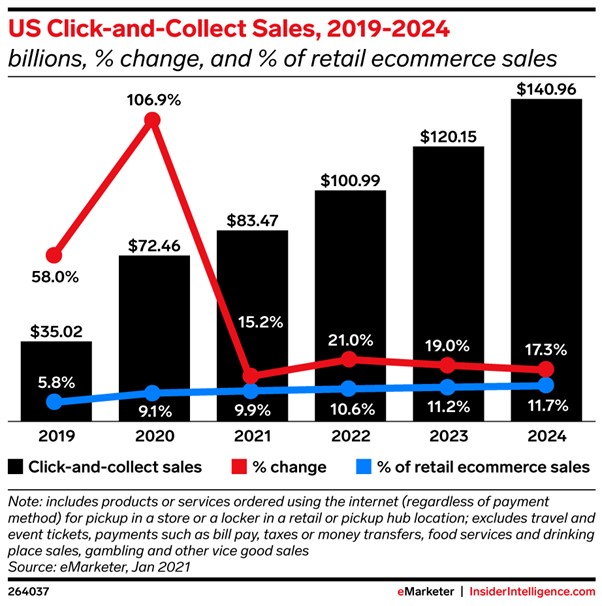
Offer a variety of payment options
Customers who reach your payment page have the highest purchase intent. Yet 44% of them will abandon their purchase if a retailer doesn’t offer their preferred payment options.
CX is about catering to every customer’s needs, and payment is an important part of those needs. Retailers should strive to offer every popular payment option available, so customers using all types of cards and online payment systems can convert with ease.
Buy now, pay later (BNPL) is a fast-growing consumer expectation. Salesforce reported 7% of all global online orders were paid for through BNPL offerings during the peak holiday season shopping period 2021, which represents 48% YOY growth.

As with BOPIS, even if most customers aren’t using BNPL, the number who are is likely to grow, and retailers who neglect this growth will lose out on a non-trivial number of sales.
9. Step-up on shipping & deliver on delivery
The primary focus of this article has been on optimizing and improving the customer experience on your ecommerce website. But the assurances you give customers on post-purchase factors like delivery, returns, and product tracking are key to giving them the confidence to purchase. And “delivering” on these assurances is crucial to meeting and exceeding these expectations.
In Digital Commerce 360’s online shopper survey, shipping-related factors were five of the top ten most important factors in choosing an online retailer.

Fast and free shipping
Fast and free shipping is one of the most desirable aspects of ecommerce stores for customers. While retailers may lose out on revenue by having to pay shipping costs out of pocket, these costs are often made up for by increased conversion rates, higher order value, and repeat buyers.
A massive 73% of consumers say free shipping greatly impacts their decision to purchase, and 24% of shoppers are willing to spend more to qualify for free shipping.

Free returns
When you’re looking to improve customer experience, a flexible returns policy or free returns are a must. 84% of online shoppers would say goodbye to a retailer after a bad returns experience, and 51% of customers reported that having to pay for returns would prevent them from making a purchase.
Over 50% of ecommerce companies in North America and Europe already offer free returns, so if your ecommerce store isn’t offering free returns in some capacity, you can expect customers to turn to a retailer that is.
Winning on the ecommerce CX battleground
The rise of ecommerce has put the power in the hands of the customer. People are no longer limited to the stores at their local shopping center, and no longer rely on mere word-of-mouth and sales staff for information.
This shift is at the center of the rising focus on improving ecommerce CX among retailers everywhere. When customers have thousands of options for online shopping and are exposed to hundreds of advertisements daily, it’s the experiences they have with brands that stand out from the noise. And it’s up to retailers to optimize that experience to keep customers coming back for more.
The CX tips and tricks we’ve outlined in this article are backed by dozens of consumer surveys and reports. Many of them are already being used by major retailers across the globe. If you’re looking to win on the new retail battleground and boost your ecommerce CX, consider these 9 strategies:
- Personalize the shopping experience
- Bolster customer service
- Strengthen your UX foundations
- Take your UX to the next level
- Tap into social proof and reviews
- Create compelling content
- Highlight brand values
- Make shopping flexible and easy
- Step-up on shipping and deliver on delivery
(This blog has been updated since it was written in 2022).